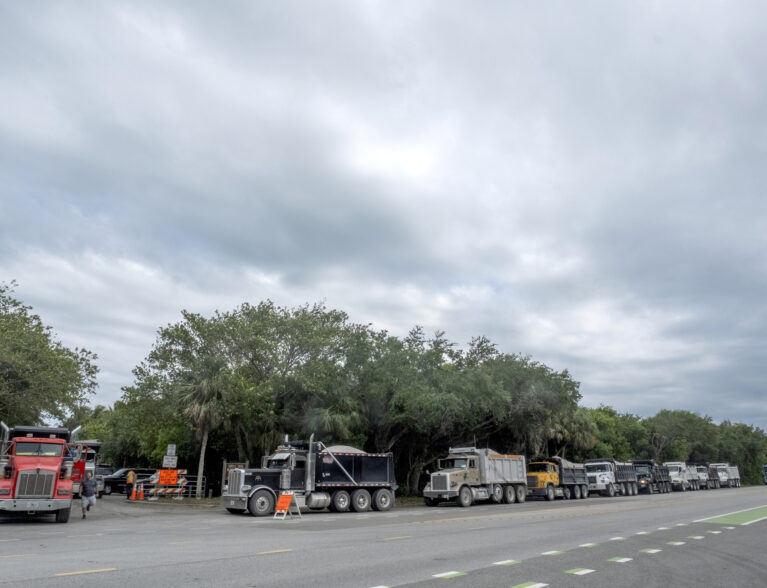
The dune replenishment effort along a 6.6-mile stretch of the barrier island from Treasure Shores Beach Park to John’s Island is forging carefully forward with “extensive sea turtle monitoring efforts” in place, but the project could push right up against its April 30 permit deadline.
Last week, trucks filled with sand lined up on A1A waiting their turn to dump sand. The project is permitted through April 30, and the contractor is authorized to place approximately 275,000 cubic yards of sand and install 750,000 dune plants through that date.
Sea turtle nesting season for Leatherback turtles began on March 1, but based on nesting time graphs from previous years, project completion should take place well before peak time.
According to Indian River County Acting Natural Resources Director Eric Charest, approximately half of the project – deemed Sector 3 by the county’s beach management plan – has already received dune plants. Dune planting takes place as the contractor finishes placing sand on stretches of dune.
“The county’s contractor for the Hurricane Ian and Nicole Sector 3 Dune Renourishment project continues to perform exceptionally well. The contractor’s initiative to bring on additional crews in order to overcome weather delays experienced early on in the project demonstrates their commitment to successfully completing the project and restoring nearly 6.6 miles of Sector 3 dunes,” said Charest, adding that the project is on track to be completed by the deadline.
Site preparation started Nov. 27, with mobilization into Treasure Shores Beach Access Park.
Sand placement began on Dec. 1.
The project area includes the Town of Orchid, Wabasso Beach, Indian River Shores and portions of unincorporated Indian River County. Turtle Trail Beach has been closed to the public, and construction progress will dictate its reopening. “At this point, the best schedule I could provide to you would be that the park will remain closed until construction is completed or April 30, whichever comes earlier,” Charest said.
The Indian River County Sea Turtle Conservation Program’s public data dashboard shows three leatherback nests identified as of last week, and no loggerhead or green nests thus far for the 2024 season. Sea turtle nesting season runs from March 1 to Oct. 31. Of the three types of turtles found nesting in Indian River County, leatherbacks arrive first, followed by loggerheads and green turtles. Last year, sea turtle nesting totals broke records along the 22.4 miles of county shoreline.
There was a grand total of 12,771 nests for the three, and both the loggerhead and green turtle nests broke records. A total of 27 leatherback nests, 8,639 loggerhead nests and 4,105 green nests were found. Indian River County totals for all three types of sea turtles jumped from 9,355 to 12,771 from 2022 to 2023. Loggerhead turtles are the most common type of sea turtle found in Florida.
During nesting season, only about 10 percent of the nests are marked with wooden stakes and flagging tape. Most nests incubate unmarked in the sand. In 2023, the first loggerhead nest was found in mid-April. A green turtle nest was found in the second week of May and a leatherback during the first week of the season. Overall, nesting peaked after April 30, with leatherbacks peaking at the beginning of May, loggerheads in mid-June, and green turtles at the end of July.
Ideally all beach construction would be completed by March 1, but days lost to bad weather and equipment issues nearly always mean delays. The drop-dead deadline for beach construction is April 30. Any work that spans a few days beyond that requires a successful appeal to the Florida Department of Environmental Protection and the U.S. Army Corps of Engineers for a permit extension.
Indian River Shores officials had hoped their town’s beaches could get an influx of sand this spring, too, before hurricane season, but that project is still tied up in Tallahassee.



